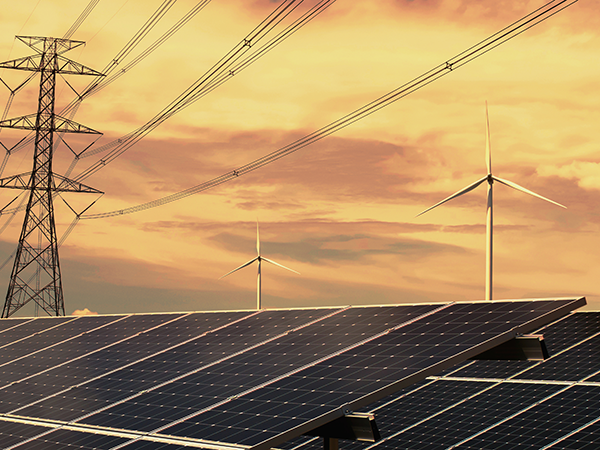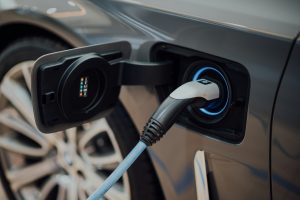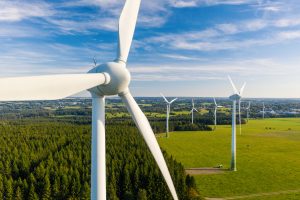War, inflation and the energy transition

Putin’s war in Ukraine has reminded policy makers and investors that the environmental imperative to decarbonize and promote energy efficiency aligns with the geopolitical benefits of energy security. Wind, solar and other clean and renewable power sources reduce dependence on piped gas and other imported black energy sources – and are the cheapest source of energy in terms of deployment.
1
The crisis in Ukraine has reminded the market that in the long run,
Renewable energy
Clean energy catalyst
Since the invasion, the S&P Clean Energy Index has outperformed global equities (MSCI ACWI) by 10%. 2 There’s no doubt this alignment – energy security and increasing renewable investment – is resonating and creating a positive catalyst for companies in the industrial value chain, such as turbine and solar module manufacturers and their component suppliers. In the last week, Germany’s government has announced plans to pull forward its goal for 100% renewable electricity from 2050 to 2035. 3 The proposal could significantly boost wind and solar demand this decade, with the German Economy Ministry projecting annual solar installations could rise to 20 gigawatts (GW) in 2028 — compound annual growth of 21%. Similarly, German wind installations could increase more than six-fold from around 3 GW in 2021 to 19 GW in 2030. 4
Public policy pusy
Europe relies on Russia for around 40% of its natural gas, 5 much of which is used to generate electricity. The latest REPowerEU announcement from the EU states clearly a quickening of the transition to clean and renewable energy. In the press release the Commission proposes to
“develop a REPowerEU plan that will increase the resilience of the EU-wide energy system based on two pillars: diversifying gas supplies, via higher Liquefied Natural Gas (LNG) and pipeline imports from non-Russian suppliers, and larger volumes of biomethane and renewable hydrogen production and imports; and, reducing the use of fossil fuels in our homes, buildings, industry, and power system, by boosting energy efficiency, increasing renewables and electrification, and addressing infrastructure bottlenecks”.
the european commission
The REPowerEU plan could see the EU gradually remove at least 155 billion cubic metres (bcm) of fossil gas use, which is equivalent to the volume imported from Russia in 2021. Nearly two thirds of that reduction can be achieved within a year, ending the EU’s overdependence on a single supplier. 6 This new strategy could be game changing. There’s a clear commitment to a quickening of the pace of transition. As the RepowerEU strategy is digested, it’s important to recognise that while solar and wind can be a long term substitute for fossil fuels, given challenges around intermittency, it will be as important to have a holistic view of the energy transition. That means looking to energy storage and the role of alternative energy sources like hydrogen, 7 as outlined by the EU.
Reducing energy demand
As well as diversifying supply away from fossil fuels, there’s the parallel requirement to address: lowering energy demand overall. This should help companies focused on improving building energy efficiency. Noted in President Biden’s State of the Union address on 1st March,
“let’s provide investments and tax credits to weatherize your homes and businesses to be energy efficient and you get a tax credit.” 8
President Biden
In Europe, for example, nearly 35% of buildings are over 50 years old and almost 75% of the building stock is classified as being energy inefficient. 9 Investments into design, insulation and smart temperature control can all contribute to a dramatic reduction in the 40% share of total demand that buildings in Europe consume. 10 Consumer awareness is also key to lowering energy demand. The IEA recently highlighted that adjusting our home thermostats by 1C 11 would save about 10 bcm of gas within a year, if implemented alongside the other measures, like the use of smart meters, more energy efficient products, and home insulation. That’s a saving on total Russian gas imports of 155 bcm. Enabling consumers to be more energy smart is part and parcel of the transition.
Relieving inflation pressures
Biden also reminded the market that in the long term, investing in renewables can also help tackle inflation, stating that a renewable energy investment programme could save American families $500 per year in energy cost. 12 In the long term, renewables are expected to be cheaper than fossil fuels – many of them already are. According to The International Renewable Energy Agency (IRENA), 13 almost two-thirds of renewable energy schemes built globally in 2020 were expected to undercut coal costs. IRENA also confirmed that the cost of new windfarms and solar panels dramatically fell during 2020 which meant 62% of new renewable energy projects could undercut the cost of up to 800 GW worth of coal plants. That’s almost enough to supply the UK’s electricity needs 10 times over. Solar power costs also fell by 16% in 2020, while the cost of onshore wind dropped 13% and offshore wind by 9%. 14
Renewables display inverse marginal costs curves relative to oil and gas; The more investment that goes into renewable energy technology, the cheaper it becomes with learning and component production efficiencies. With oil, marginal sources are ever more expensive and difficult to drill for.
There are no positives to be drawn from war. Humanitarian and policy responses from governments are a salient reminder to us all that the
Climate crisis
Footnotes
- Scroll to footnote
-
Bloomberg, correct to close 7th March 2022Scroll to footnote
- Scroll to footnote
- Scroll to footnote
- Scroll to footnote
- Scroll to footnote
- Scroll to footnote
- Scroll to footnote
- Scroll to footnote
- Scroll to footnote
- Scroll to footnote
- Scroll to footnote
- Scroll to footnote
-
ibidScroll to footnote




